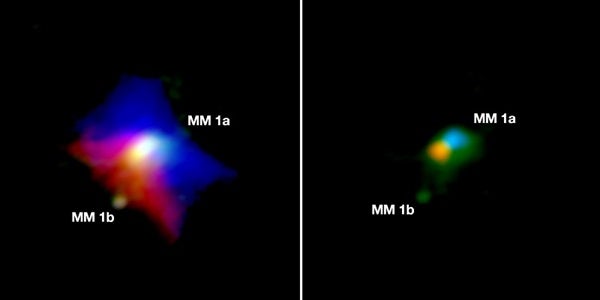Massive Star MM 1a Forms Companion Star MM 1b in Its Fragmented Disk
TL;DR
Astronomers discovered MM 1b forming outside the massive star MM 1a in a fragmented disk, overturning previous expectations. This unusual occurrence illustrates that large disks can produce stars instead of planets, highlighting the complexities of star formation. The research utilized advanced ALMA technology to reveal the distinct masses of both stars, demonstrating how MM 1b emerged from MM 1a’s disk. The eventual demise of these stars serves as a reminder of the transient nature of massive star systems, prompting further exploration to understand their formation and interactions.
After reading the article, Jamie Lee gained more than 260 upvotes with this comment: “Isn’t that something. If gravity was a stronger force would it do that? Or would the gas clouds quickly form little droplets that would gravitationally pull against each other in all directions? Holding themselves into into a crystalline matrix structure of vibrating droplet gravity. Thinking in the beginning of the universe where cmb data indicates near uniformity of temperature and density.” Be sure to discuss this topic in the comments!
___________________
There are many surprises in the universe, and a massive young star has been hiding a stellar one.
While observing infant star MM 1a, astronomers found that its massive disk was actually forming another star instead of planets. The much smaller companion, known as MM 1b, was discovered slightly outside the dusty disk surrounding the massive star and may even contain a planet-forming disk of its own. The discovery of the new star, published in the Astrophysical Journal Letters, marks one of the first times astronomers saw a star forming in the fragmented disk of another.
Stellar Siblings
The formation of binary stars, which are rather common in the universe, is believed to occur from a massive cloud of gas and dust that collapses under the force of its own gravity, just like single stars do. A big enough molecular cloud can give birth to two stars of comparable size rather than just one.
Furthermore, the discovery of MM 1a surprised astronomers from the University of Leeds since binary pairs are relatively easy to find. Homing in on the seemingly single star, they found an unexpected, much smaller companion star lurking in the outskirts of its dense disk — the region of dust and gas where planets typically form.
John Ilee, head of the study and a researcher at the University of Leeds, said in a news release that “in this case, the star and disk we have observed is so massive that, rather than witnessing a planet forming in the disk, we are seeing another star being born.”

To shed light on the peculiar pair, the researchers used the Atacama Large Millimetre/submillimetre Array (ALMA) to probe the star system — observing the light frequencies that emit from the disk’s gas and measuring the radiation that emits from the disk’s dust. They used this information to calculate the mass of the stars, and found that MM 1a is about 40 times the mass of our Sun, and that MM 1b weighs just half our Sun’s mass.
The researchers believe that MM 1b was actually born in a fragment of MM 1a’s disk in order to explain this stark contrast. They think that because of its large mass, the disk broke apart into fragments because it was unable to withstand its own gravity. In addition to containing enough gas and dust to form the low mass companion star, one of those fragments may have also contained a planet-forming disk.
Unfortunately, both of these stars and their prospective planets will soon meet a grim end. Massive stars like MM 1a have relatively short lives, and in approximately a million years, a supernova will likely wipe out the entire system. In contrast, lower mass stars like MM 1b have long lifespans.
Despite the potentially catastrophic repercussions, this finding represents one of the rare occasions when astronomers have witnessed a star emerge from its companion’s broken disk. The discovery may aid in the understanding of the odd star systems in our universe and serve as a reminder that many star mysteries remain unanswered.



This is cool, but is it really surprising that one star in a binary system would form before the other?
I thought it was always just assumed that Jupiter-sized planets formation is pretty much the same as star formation, but since the mass isn’t enough to initiate fusion, it never gets the status of “star”.
The article says:
The formation of binary stars, which are rather common in the universe, is believed to occur from a massive cloud of gas and dust that collapses under the force of its own gravity, just like single stars do. A big enough molecular cloud can give birth to two stars of comparable size rather than just one.
Yes, that’s true, but nothing about that indicates that the two stars form simultaneously. In cases where one cloud is much larger than the other, it seems obvious that the bigger would collapse into a star first.
It’s still cool that we get to see it happening, and that we have instrumentation good enough that we can recognize that it’s happening. But, it doesn’t seem to change any theories about star formation. I could be wrong. If someone else knows more than me, feel free to share.
This is where Tatooine is!
But seriously, theoretically could this system have a really bizarre forever changing Goldilocks zone?
I was suggested this web site by my cousin Im not sure whether this post is written by him as no one else know such detailed about my trouble You are incredible Thanks
I have been surfing online more than 3 hours today yet I never found any interesting article like yours It is pretty worth enough for me In my opinion if all web owners and bloggers made good content as you did the web will be much more useful than ever before